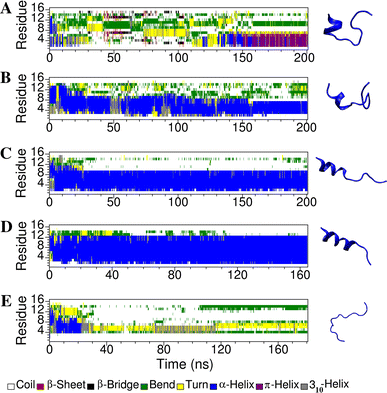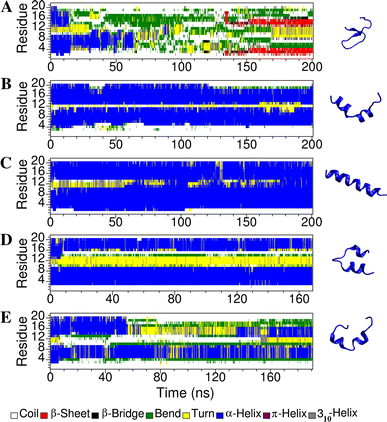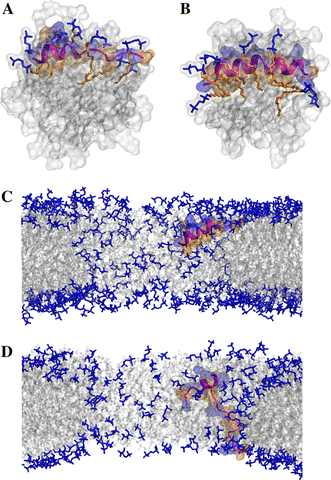The effect of membrane curvature on the conformation of antimicrobial peptides: implications for binding and the mechanism of action
- PMID: 21267557
- PMCID: PMC3070085
- DOI: 10.1007/s00249-011-0677-4
The effect of membrane curvature on the conformation of antimicrobial peptides: implications for binding and the mechanism of action
Abstract
Short cationic antimicrobial peptides (AMPs) are believed to act either by inducing transmembrane pores or disrupting membranes in a detergent-like manner. For example, the antimicrobial peptides aurein 1.2, citropin 1.1, maculatin 1.1 and caerin 1.1, despite being closely related, appear to act by fundamentally different mechanisms depending on their length. Using molecular dynamics simulations, the structural properties of these four peptides have been examined in solution as well as in a variety of membrane environments. It is shown that each of the peptides has a strong preference for binding to regions of high membrane curvature and that the structure of the peptides is dependent on the degree of local curvature. This suggests that the shorter peptides aurein 1.2 and citropin 1.1 act via a detergent-like mechanism because they can induce high local, but not long-range curvature, whereas the longer peptides maculatin 1.1 and caerin 1.1 require longer range curvature to fold and thus bind to and stabilize transmembrane pores.
Figures




Similar articles
-
Membrane interactions of antimicrobial peptides from Australian frogs.Biochim Biophys Acta. 2009 Aug;1788(8):1630-8. doi: 10.1016/j.bbamem.2008.10.007. Epub 2008 Oct 25. Biochim Biophys Acta. 2009. PMID: 19013126 Review.
-
Interactions of the Australian tree frog antimicrobial peptides aurein 1.2, citropin 1.1 and maculatin 1.1 with lipid model membranes: differential scanning calorimetric and Fourier transform infrared spectroscopic studies.Biochim Biophys Acta. 2007 Nov;1768(11):2787-800. doi: 10.1016/j.bbamem.2007.07.018. Epub 2007 Aug 10. Biochim Biophys Acta. 2007. PMID: 17825246
-
Comparison of reversible membrane destabilisation induced by antimicrobial peptides derived from Australian frogs.Biochim Biophys Acta. 2014 Sep;1838(9):2205-15. doi: 10.1016/j.bbamem.2014.02.017. Epub 2014 Mar 1. Biochim Biophys Acta. 2014. PMID: 24593995
-
A coarse-grained approach to studying the interactions of the antimicrobial peptides aurein 1.2 and maculatin 1.1 with POPG/POPE lipid mixtures.J Mol Model. 2018 Jul 17;24(8):208. doi: 10.1007/s00894-018-3747-z. J Mol Model. 2018. PMID: 30019106
-
A Review of the Mechanism of Action of Amphibian Antimicrobial Peptides Focusing on Peptide-Membrane Interaction and Membrane Curvature.Curr Protein Pept Sci. 2017;18(12):1263-1272. doi: 10.2174/1389203718666170710114932. Curr Protein Pept Sci. 2017. PMID: 28699512 Review.
Cited by
-
Mechanistic Insights into the Membrane Permeabilization Activity of Antimicrobial Prenylated Isoflavonoids: A Comparative Study of Glabridin, Wighteone, and Lupiwighteone.J Agric Food Chem. 2025 Mar 19;73(11):6668-6677. doi: 10.1021/acs.jafc.5c01688. Epub 2025 Mar 5. J Agric Food Chem. 2025. PMID: 40040444 Free PMC article.
-
The Addition of a Synthetic LPS-Targeting Domain Improves Serum Stability While Maintaining Antimicrobial, Antibiofilm, and Cell Stimulating Properties of an Antimicrobial Peptide.Biomolecules. 2020 Jul 8;10(7):1014. doi: 10.3390/biom10071014. Biomolecules. 2020. PMID: 32650576 Free PMC article.
-
Antimicrobial Peptides Share a Common Interaction Driven by Membrane Line Tension Reduction.Biophys J. 2016 Nov 15;111(10):2176-2189. doi: 10.1016/j.bpj.2016.10.003. Biophys J. 2016. PMID: 27851941 Free PMC article.
-
The effect of amidation on the behaviour of antimicrobial peptides.Eur Biophys J. 2016 Apr;45(3):195-207. doi: 10.1007/s00249-015-1094-x. Epub 2016 Jan 8. Eur Biophys J. 2016. PMID: 26745958 Free PMC article.
-
LipidWrapper: an algorithm for generating large-scale membrane models of arbitrary geometry.PLoS Comput Biol. 2014 Jul 17;10(7):e1003720. doi: 10.1371/journal.pcbi.1003720. eCollection 2014 Jul. PLoS Comput Biol. 2014. PMID: 25032790 Free PMC article.
References
-
- Anézo C, de Vries AH, Höltje HD, Tieleman DP, Marrink S-J. Methodological issues in lipid bilayer simulations. J Phys Chem B. 2003;107:9424–9433. doi: 10.1021/jp0348981. - DOI
-
- Apponyi MA, Pukala TL, Brinkworth CS, Maselli VM, Bowie JH, Tyler MJ, Booker GW, Wallace JC, Carver JA, Separovic F, Doyle J, Llewellyn LE. Host-defence peptides of Australian anurans: structure, mechanism of action and evolutionary significance. Peptides. 2004;25:1035–1054. doi: 10.1016/j.peptides.2004.03.006. - DOI - PubMed
Publication types
MeSH terms
Substances
LinkOut - more resources
Full Text Sources

